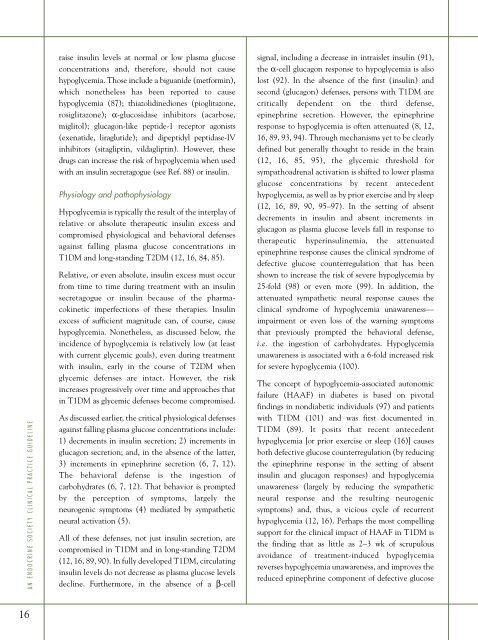Evaluation & Management of Adult Hypoglycemic Disorders
Evaluation & Management of Adult Hypoglycemic Disorders
Evaluation & Management of Adult Hypoglycemic Disorders
Create successful ePaper yourself
Turn your PDF publications into a flip-book with our unique Google optimized e-Paper software.
AN ENDOCRINE SOCIETY CLINICAL PRACTICE GUIDELINE<br />
16<br />
raise insulin levels at normal or low plasma glucose<br />
concentrations and, therefore, should not cause<br />
hypoglycemia. Those include a biguanide (metformin),<br />
which nonetheless has been reported to cause<br />
hypoglycemia (87); thiazolidinediones (pioglitazone,<br />
rosiglitazone); α-glucosidase inhibitors (acarbose,<br />
miglitol); glucagon-like peptide-1 receptor agonists<br />
(exenatide, liraglutide); and dipeptidyl peptidase-IV<br />
inhibitors (sitagliptin, vildagliptin). However, these<br />
drugs can increase the risk <strong>of</strong> hypoglycemia when used<br />
with an insulin secretagogue (see Ref. 88) or insulin.<br />
Physiology and pathophysiology<br />
Hypoglycemia is typically the result <strong>of</strong> the interplay <strong>of</strong><br />
relative or absolute therapeutic insulin excess and<br />
compromised physiological and behavioral defenses<br />
against falling plasma glucose concentrations in<br />
T1DM and long-standing T2DM (12, 16, 84, 85).<br />
Relative, or even absolute, insulin excess must occur<br />
from time to time during treatment with an insulin<br />
secretagogue or insulin because <strong>of</strong> the pharmacokinetic<br />
imperfections <strong>of</strong> these therapies. Insulin<br />
excess <strong>of</strong> sufficient magnitude can, <strong>of</strong> course, cause<br />
hypoglycemia. Nonetheless, as discussed below, the<br />
incidence <strong>of</strong> hypoglycemia is relatively low (at least<br />
with current glycemic goals), even during treatment<br />
with insulin, early in the course <strong>of</strong> T2DM when<br />
glycemic defenses are intact. However, the risk<br />
increases progressively over time and approaches that<br />
in T1DM as glycemic defenses become compromised.<br />
As discussed earlier, the critical physiological defenses<br />
against falling plasma glucose concentrations include:<br />
1) decrements in insulin secretion; 2) increments in<br />
glucagon secretion; and, in the absence <strong>of</strong> the latter,<br />
3) increments in epinephrine secretion (6, 7, 12).<br />
The behavioral defense is the ingestion <strong>of</strong><br />
carbohydrates (6, 7, 12). That behavior is prompted<br />
by the perception <strong>of</strong> symptoms, largely the<br />
neurogenic symptoms (4) mediated by sympathetic<br />
neural activation (5).<br />
All <strong>of</strong> these defenses, not just insulin secretion, are<br />
compromised in T1DM and in long-standing T2DM<br />
(12, 16, 89, 90). In fully developed T1DM, circulating<br />
insulin levels do not decrease as plasma glucose levels<br />
decline. Furthermore, in the absence <strong>of</strong> a β-cell<br />
signal, including a decrease in intraislet insulin (91),<br />
the α-cell glucagon response to hypoglycemia is also<br />
lost (92). In the absence <strong>of</strong> the first (insulin) and<br />
second (glucagon) defenses, persons with T1DM are<br />
critically dependent on the third defense,<br />
epinephrine secretion. However, the epinephrine<br />
response to hypoglycemia is <strong>of</strong>ten attenuated (8, 12,<br />
16, 89, 93, 94). Through mechanisms yet to be clearly<br />
defined but generally thought to reside in the brain<br />
(12, 16, 85, 95), the glycemic threshold for<br />
sympathoadrenal activation is shifted to lower plasma<br />
glucose concentrations by recent antecedent<br />
hypoglycemia, as well as by prior exercise and by sleep<br />
(12, 16, 89, 90, 95–97). In the setting <strong>of</strong> absent<br />
decrements in insulin and absent increments in<br />
glucagon as plasma glucose levels fall in response to<br />
therapeutic hyperinsulinemia, the attenuated<br />
epinephrine response causes the clinical syndrome <strong>of</strong><br />
defective glucose counterregulation that has been<br />
shown to increase the risk <strong>of</strong> severe hypoglycemia by<br />
25-fold (98) or even more (99). In addition, the<br />
attenuated sympathetic neural response causes the<br />
clinical syndrome <strong>of</strong> hypoglycemia unawareness—<br />
impairment or even loss <strong>of</strong> the warning symptoms<br />
that previously prompted the behavioral defense,<br />
i.e. the ingestion <strong>of</strong> carbohydrates. Hypoglycemia<br />
unawareness is associated with a 6-fold increased risk<br />
for severe hypoglycemia (100).<br />
The concept <strong>of</strong> hypoglycemia-associated autonomic<br />
failure (HAAF) in diabetes is based on pivotal<br />
findings in nondiabetic individuals (97) and patients<br />
with T1DM (101) and was first documented in<br />
T1DM (89). It posits that recent antecedent<br />
hypoglycemia [or prior exercise or sleep (16)] causes<br />
both defective glucose counterregulation (by reducing<br />
the epinephrine response in the setting <strong>of</strong> absent<br />
insulin and glucagon responses) and hypoglycemia<br />
unawareness (largely by reducing the sympathetic<br />
neural response and the resulting neurogenic<br />
symptoms) and, thus, a vicious cycle <strong>of</strong> recurrent<br />
hypoglycemia (12, 16). Perhaps the most compelling<br />
support for the clinical impact <strong>of</strong> HAAF in T1DM is<br />
the finding that as little as 2–3 wk <strong>of</strong> scrupulous<br />
avoidance <strong>of</strong> treatment-induced hypoglycemia<br />
reverses hypoglycemia unawareness, and improves the<br />
reduced epinephrine component <strong>of</strong> defective glucose


